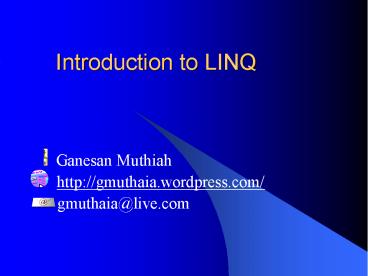Introduction to LINQ PowerPoint PPT Presentation
Title: Introduction to LINQ
1
Introduction to LINQ
- Ganesan Muthiah
- http//gmuthaia.wordpress.com/
- gmuthaia_at_live.com
2
Introduction
- How do you interrogate/manipulate data?
- What if you could do the work in a type-safe,"
string-free manner? - What if you could use a consistent querying
syntax for data, objects or XML?
3
Agenda
- What is LINQ
- Queries without LINQ
- Key features of LINQ
- LINQ Architecture
- LINQ to
4
What is LINQ?
- Language Integrated Query
- Make query a part of the language
- Component of .NET Framework 3.5
5
Queries without LINQ
6
Key Features of LINQ
- Delayed Execution
- LINQ queries don't execute until they must
- Retrieve specific values
- Iterate through the collection
- Perform an operation
- Write Data Access Code directly
- Compile time syntax and schema checking
(intellisense too) - no need of inline sql or to wait until runtime to
see if it is ok - LINQ data access code abstracted from underlying
data - consistent syntax across various data sources
- can join information from different sources.
7
Architecture
8
LINQ to
- LINQ to Objects
- LINQ to SQL (formerly known as DLINQ)
- LINQ to XML (formerly known as XLINQ)
- LINQ to Entities (ADO.NET Entities)
9
LINQ to Objects
- Query any IEnumerableltTgt sourceIncludes arrays,
ListltTgt, Dictionary... - Many useful operators availableSum, Max, Min,
Distinct, Intersect, Union - Expose your own data with IEnumerableltTgt or
IQueryableltTgt - Create operators using extension methods
10
LINQ to Objects
- DEMO
11
LINQ to SQL (formerly known as DLinq)
- Object-relational mapping (ORM)
- Records become strongly-typed objects.
- Includes tracking of changed objects and
persistence. - Ensures that you will not obtain multiple objects
for the same underlying row in the database (
Fowlers Identity Map) - Data context is the controller mechanism
- Facilitates update, delete insert
- Type, parameter and injection safe
12
LINQ to SQL
- DEMO
13
LINQ to XML (formerly known as XLinq)
- Similar to LINQ to SQL but along the idea of
querying XML documents using LINQ syntax rather
than the XPath/XQuery syntax.
14
LINQ to XML
- DEMO
15
LINQ to Entities
- LINQ to Entities (ADO.NET Entities)
- A more advanced ORM solution that allows more
extensive mapping and manipulation between how
the object appears and the underlying data
source. - LINQ to Entity provides
- Excellent build support if it isn't mapped
100, it won't build - It works with other databases (I'm currently
using it with Oracle) - It properly seperates the structural model from
the conceptual entity model. - It maps many to many relationships properly.
16
LINQ to Entities
- DEMO
17
Summary
- Had a quick intro on
- LINQ and its need
- Key Language features
- LINQ Architecture
- LINQ Types
- LINQ Operators
18
For more information.
- Official site
- http//msdn.microsoft.com/en-us/netframework/aa904
594.aspx - Tutorials
- http//weblogs.asp.net/scottgu/archive/tags/LINQ/d
efault.aspx - 101 LINQ Samples
- http//msdn.microsoft.com/en-us/vcsharp/aa336746.a
spx - LINQ Pad
- http//www.linqpad.net/
19
- Thank you
- Questions?

